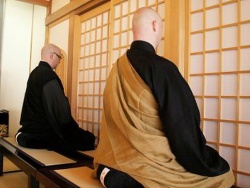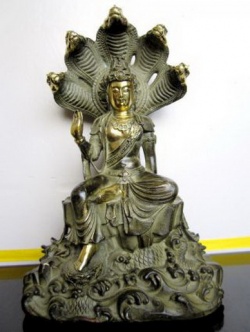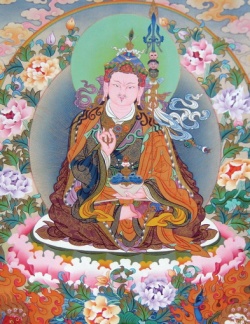Can laymen attain liberation in non-Tantric traditions?
Someone wrote: "What are the methods non-tantric buddhism has for this? I know of vipashyana but do not know how it is practiced in classical buddhism. Does anyone know? Is it reasonable for a modern layman to expect liberation from all personal karmas with this method, without tantric tools?"
I replied:
Even in the earliest tradition of Buddhism, the Buddha himself have stated that the numbers of his lay followers attaining the stage of non returner were numbering in the range of thousand ( Majjhima Nikaya 73 ), likewise for lay once returners or lay stream enterers, in other words in addition to removing the first three fetters of self-view, attachment to rites and rituals, and skeptical doubt, a very substantial number of his lay students also attained the elimination of the fetter of 'sensual desire' and 'ill will', therefore they will no longer take birth in the sensual planes like the human and lower deva realms, and instead at most be reborn one more time in the pure abodes to attain arahantship there. That's non-tantric Buddhism.
Are there lay arahants? Yes, a number of arahants have attained arahantship as laymen in the suttas, however, interestingly all the laymen arahants simply renounced after attaining full arahantship. Why is this so? I can only say, with my own logical deduction (since I am not arahant), that since arahants have cut off all attachments, they simply are completely unattached to worldly life, they have no more interest in living a worldly life or enjoying pleasures of the worldly life. They have no more attachments to family ties or material belongings at all, and see no more reason to continue living as a lay man. I think they would rather live a simple life of pleasant abiding in their nirvanic bliss. This however does not mean they no longer engage in human interactions - many arahants are known to have many students in dharma and continue to benefit many people.
Now when it comes to later forms of Buddhism, like Mahayana Buddhism, (even before the formation of Tantric Buddhism), there is becoming greater and greater emphasis on the role of a lay person in Buddhism. It does not mean that laymen have no role in Theravada Buddhism - in the suttas, one of the layman (I think was either a sakadagami or an anagami) was designated as the 'best lay dharma teacher' (in fact - one best lay Male and one best lay Female lay dharma teacher) basically by the Buddha, which also indicates his approval for experienced laymen and laywomen to teach the dharma, and the potential for laymen to be advanced in dharma practice and knowledge... nonetheless later on as the Theravada tradition developed it would appear that the emphasis has been more on the monastic community. It is unfortunate that in many Asian Theravada countries, most lay people only aim for gaining merits (e.g. through giving alms to monks) to be reborn in a higher realm or as a monk in the future lifetime, since they do not believe it is realistic for them to attain awakening and liberation as a lay person. This is without any scriptural basis, since their scriptures clearly state that there were abundance of awakened lay persons. This is especially so in recent centuries whereby Theravada has degenerated quite a bit, and it is only in the recent 1-2 century that there has been revival of the vipassana practices and emphasis on bringing dharma to lay practitioners, which has seen very good results so far. More and more people - monastic and lay practitioners alike are learning to do vipassana meditation.
So, it is accepted notion even in the earliest tradition that laymen have great potential to attain liberation, and that Nirvana is not limited only for monastic monks and nuns. Nonetheless there is more emphasis on cultivation and practice within the monastic context.
The Mahayana further shifts the focus away from monastic to the lay people and community. i.e. all the images of Bodhisattvas you see are almost always in the form of laymen, there is only Ksitigarbha Bodhisattva which manifested as a monastic monk. In the Vimalakirti Sutra, the Vimalakirti Bodhisattva is a 10th stage bhumi bodhisattva living as a lay person completely engaged in living the lay life and benefitting people in all walks of life, which probably became the role model for the emphasis of 'entering the marketplace' in Zen Buddhism. Because of this, laymen are seen in Mahayana (including non-tantric) Buddhism to be as equally capable of attaining the fruition of spiritual life as a monastic person.
"The character of Vimalakirti is a pretext to express the teaching on emptiness ⎯ the ungraspability of phenomena ⎯ the most difficult aspect of the Buddhist teachings. He manifests this aspect by presenting seemingly contradictory characteristics: he lives alone yet he is surrounded by many servants; he lives a life of celibacy yet has a wife and children. He takes the teachings of the Buddha into every context: bars, brothels, schools and the market place. Vimalakirti is completely integrated within Indian society and, as a fictional figure, he illustrates integration in any type of society." -- http://www.vimalakirtiusa.org/about_vimalakirti.html
The practice and engagement of the 10 paramitas (or 6) in the daily life becomes of utmost importance, allowing the twofold cultivation of merits and wisdom so necessary for the attainment of full Buddhahood. It is in fact in the very mundane activities of daily life and interactions that allows us the opportunity to attain the ten perfections (paramitas) that allows us to attain full Buddhahood. The paramitas are not just 'mundane qualities', but the actualization of awakened wisdom - for example, the perfection of generosity is not just the ability to give lots of money to other people, but rather, the selfless giving freed from any confusion of a giver-giving-gift. The wisdom of the emptiness of self and phenomena allows our act of generosity to be perfected. When our giving transcends giver-giving-gift, without attachments we relinquish and give and sacrifice for other beings out of genuine compassion, that is true generosity. The cultivation of the ten paramitas in conjunction of the wisdom of emptiness is itself a method for the liberation of taints, and does not require tantric methods, though one can very well implement them.
It is said that at each of the ten bhumi stages, one of the perfections have been perfected. For example, the first bhumi perfects the perfection of generosity, second bhumi the perfection of precepts, so on and so forth... all these are part of the so called 'common/non-tantric Mahayana' path.
In short, in the Mahayana (even non-tantric) path, as Huayan Patriarch Cheng'guan explained ( http://awakeningtoreality.blogspot.com.au/.../httpssites... ), the essential wisdom that allows for the twofold liberation of afflictive obscurations and knowledge obscurations is the wisdom of twofold emptiness (this is similar to Tantric Buddhism as well). Then there is the emphasis on cultivating the paramitas.
If you're asking about specific meditation methods, there are lots of meditation methods.
For example in the early tradition, i.e. the suttas, Theravada, etc, the four foundations of mindfulness are said to lead someone to the stage of non-returner and arahant, in at most 7 years and as little as 7 days (mahasatipatthana sutta). I would think that would mean practicing them in a very diligent manner and not merely in a half hearted way. There are many methods involved in the four foundations of mindfulness, from anapanasati, to the contemplation of the impurities of the body. Different methods are taught with different emphasis. For example, the practice of the mindfulness of breathing is very suitable for someone with a very distracted and wandering mind, full of discursive thinking. Anapanasati is very suitable for developing the sort of calm abiding, mental samadhi, etc. Whereas, the contemplation of the impurities of the body can lead to the elimination of sensual lust. So there are also in fact many kinds of practices in the early tradition that can help overcome the taints.
In Theravada Buddhism, there are number of different systems of vipassana being practiced nowadays, including for example the Mahasi Sayadaw's system which emphasizes the technique of 'noting' and the progress of insight based on Venerable Buddhaghosa's Visudhimagga, as well as the Goenka's system of vipassana practices. One similarity between them is that both emphasizes mindfulness of one's direct perception/sensations and being mindful of the three dharma seals of impermanence, unsatisfactoriness and non-self in direct experience. This leads to direct insight and realization.
The Mahayana (non-tantric) tradition has its own set of shamatha and vipashyana teachings. Venerable Dharmamitra has a number of translations including Master Zhiyi's meditation manual of the Tiantai tradition's shamatha-vipashyana methods: http://www.kalavinka.org/ . Due to a large number of various Mahayana traditions, there are focus on different methods of practices, however the many non-tantric sects of Mahayana Buddhism have in recent centuries died out only leaving Zen and Pure Land Buddhism. Zen has a system of zazen, koan, practice-enlightenment.
Also: realizing anatta does not mean that at once you will overcome all sense of grasping and mine-making. Something Thusness wrote years ago concerning the difference between I-making and mine-making:
Hi Simpo,
How have you been getting on? I am planning for my retirement.
I think after stabilizing non-dual experience and maturing the insight of anatta, practice must turn towards ‘self-releasing’ and ‘dispassion’ rather than intensifying ‘non-dual’ luminosity. Although being bare in attention or naked in awareness will help in dissolving the sense of ‘I’ and division, we must also look into dissolving the sense of ‘mine’. In my opinion, dissolving of the sense of ‘I’ does not equate to dissolving the sense of ‘mine’ and attachment to possessions can still be strong even after very stable non-dual experience. This is because the former realization only mange to eliminate the dualistic tendency while the latter requires us to embody and actualize the right view of ‘emptiness’. Very seldom do we realize it has a lot to do with our ‘view’ that we hold in our deep most consciousness. We must allow our luminous essence to meet differing conditions to realise the latent deep. All our body cells are imprinted and hardwired to ‘hold’. Not to under-estimate it.



